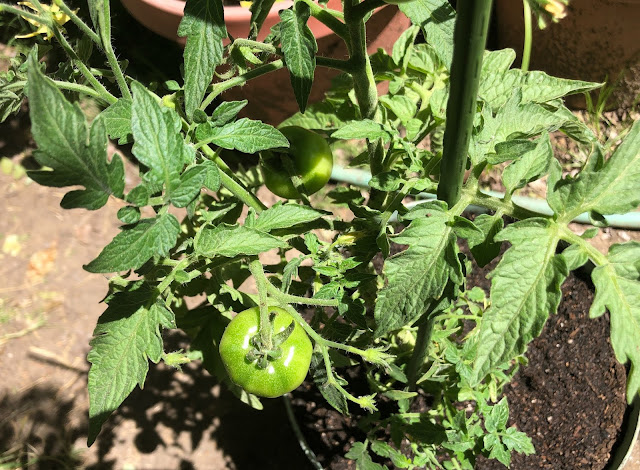
Surviving triple-digit temps comes down to moisture and mulch
 |
|
Container tomatoes, like this Orange Pixie, should be watered frequently during high temperatures. The soil can dry out much quicker than for in-ground tomatoes. (Photo: Kathy Morrison)
|
Tomatoes love heat and sun, but how much is too much?
Prolonged triple-digit heat waves can toast tomatoes and other sun-loving crops. Tomatoes in particular tend to be temperature sensitive.
When temperatures stay above 95 degrees, tomato flowers may drop off or refuse to set fruit. Leaves can fry and turn crispy. Ripening tomatoes may split or develop calluses.
Give your vines a hand – along with enough water and shade – to cope with this week’s heat. This advice comes from UC Cooperative Extension master gardeners as well as longtime local tomato growers.
* Water early and deep. Irrigate your tomatoes in the morning, making sure water reaches down at least 6 inches into the soil. How do you know? Test the soil with a probe or long screwdriver; it should easily plunge into the soil. Or use a trowel, dig down and look.
* During hot weather, water tomatoes two to three times a week. Tomatoes normally wilt during a hot afternoon; that’s OK. But if they’re wilted in the morning, water immediately. (Note: A few heirloom varieties, particularly of Russian origin, have a natural tendency to wilt all the time. But if you are growing one of these, you've probably noticed this already.)
* Tomatoes planted in containers may need extra water every day during hot weather. Their potting soil tends to dry out faster.
* Keep watering consistent and don’t let soil dry out completely. That can lead to blossom end rot, the hard brown callus on the flower end of a tomato.
* Mulch is your friend. Make sure your vines have at least 2 to 4 inches around them to help keep roots cool and soil evenly moist. Straw, leaves or shredded bark make the best tomato mulch. Many gardeners prefer straw (not hay) because its light color reflects intense sun rays instead of absorbing that added heat. (Also, hay contains seeds that can sprout and suck nutrients out of soil.)
* Don’t fertilize during a hot spell. Feeding now just puts more stress on the plant.
* Tomatoes love sun, but they can get sunburned. If leaves or developing fruit look bleached out or burned, give your vine some afternoon shade. Erect a temporary shade structure by draping burlap or shade cloth over the tomato cage or trellis. This also helps prevent fruit from cracking.
* If foliage turns brown, leave the dead leaves in place for now. They help protect the fruit from sunburn. After the heat has subsided, prune off the completely dead leaves so new foliage can grow.
Comments
0 comments have been posted.Sacramento Digs Gardening to your inbox.
Sites We Like
Garden Checklist for week of May 5
Survey your garden after the May 4 rainstorm. Heavy rain and gusty winds can break the neck of large flowers such as roses. Also:
* Keep an eye on new transplants or seedlings; they could take a pounding from the rain.
* Watch out for powdery mildew. Warmth following moist conditions can cause this fungal disease to “bloom,” too. If you see a leaf that looks like it’s dusted with powdered sugar, snip it off.
* After the storm, start setting out tomato transplants, but wait on the peppers and eggplants (they want warmer nights). Pinch off any flowers on new transplants to make them concentrate on establishing roots instead of setting premature fruit.
* Trim dead flowers but not leaves from spring-flowering bulbs such as daffodils and tulips. Those leaves gather energy to create next year's flowers. Also, give the bulbs a fertilizer boost after bloom.
* Pinch chrysanthemums back to 12 inches for fall flowers. Cut old stems to the ground.
* Mulch around plants to conserve moisture and control weeds.
* From seed, plant beans, beets, cantaloupes, carrots, corn, cucumbers, melons, pumpkins, radishes and squash.
* Plant onion sets.
* In the flower garden, plant seeds for asters, cosmos, celosia, marigolds, salvia, sunflowers and zinnias. Transplant petunias, zinnias, geraniums and other summer bloomers.
* Plant perennials and dahlia tubers for summer bloom.
* Don’t wait; plant summer bulbs, such as gladiolus and tuberous begonias.
* Harvest cabbage, lettuce, peas and green onions.